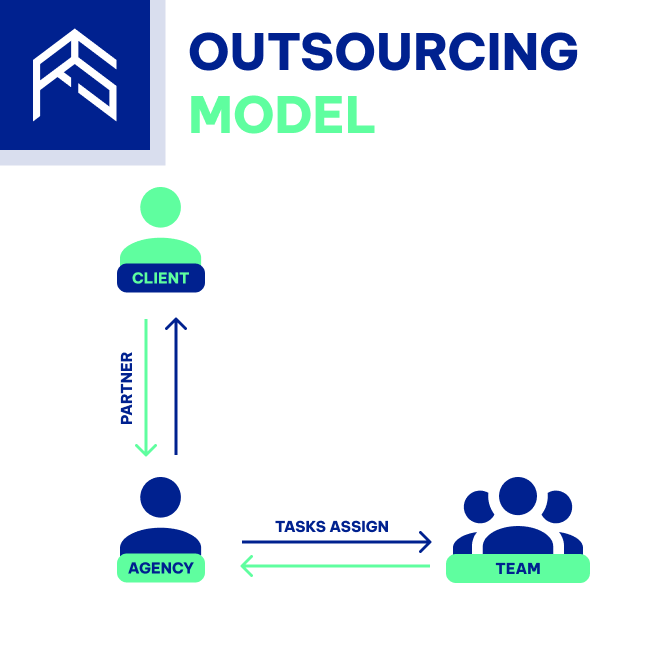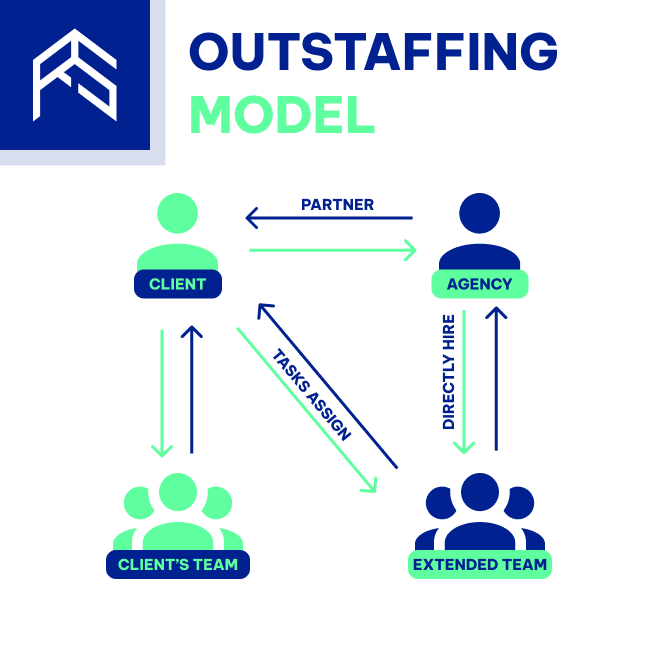As a business owner, you're always looking for ways to scale your company while controlling costs. Increasingly, companies are turning to outside vendors both at home and abroad, instead in-house hiring. Outsourcing and outstaffing are two rising options in recent years, but what exactly are the differences between them? And how do you determine which approach is right for your needs?
Defining Outsourcing and Outstaffing: The Differences Between Two Models
Outsourcing and outstaffing are two related business strategies that involve hiring external resources to perform certain tasks or functions for a company. While the terms are often used interchangeably, there are distinct differences between the two models.
1> Outsourcing
Outsourcing involves delegating business functions to an external organization called outsourcing agency. The outsourcing partner takes full responsibility for the outsourced activities. It's not common for the client to directly interact with the development team. The individuals responsible for carrying out all the project tasks often handle multiple projects concurrently.

2> Outstaffing
Outstaffing is a business practice where a company or organization hires professionals or a dedicated team from an external service provider to work on specific projects or tasks. Unlike outsourcing, where the entire project is handed over to an external company, outstaffing allows team members perform job responsibilities for a client company. However, instead of being directly hired by the client company, the person is officially employed by a separate outstaffing agency. This agency takes on the role of the employer, assuming responsibilities such as managing salaries, bonuses, taxes, and providing necessary equipment to the worker. Meanwhile, the client company remains responsible for assigning tasks and projects to the worker.
In outstaffing, the external team becomes an extension of the hiring company's workforce, often working remotely or in a separate location. This approach can be particularly useful when a company needs to quickly scale up its team to meet project demands, access specialized skills, or manage temporary workloads without the long-term commitment of hiring full-time employees.

Main Differences Between Outstaffing & Outsourcing
The key distinction lies on the level of autonomy of clients: Outstaffing services will help you hire and manage team members, while outsourcing takes care of the whole projects. Each approach has its unique advantages, so choosing the right one depends on your specific needs. Check out how our outstaffing stands out from the competition!
Deciding Between Outstaffing and Outsourcing: When to Choose?
Deciding between outstaffing and outsourcing depends on your specific needs, goals, and resources. Let's explore some considerations to help you make an informed choice.
1> When to Choose Outstaffing
- Full Control: If you want direct control over the team's composition, tasks, and project management, outstaffing may be preferable. You essentially build a remote extension of your in-house team.
- Long-Term Commitment: Outstaffing can be a good fit when you need a consistent team for ongoing projects or tasks. This model allows for better integration and collaboration over time.
- Specific Skillsets: If your projects require specialized skills and expertise that are not readily available in your current team, outstaffing allows you to handpick professionals with the exact skills you need.
- Cultural Alignment: If maintaining a cohesive company culture and alignment with your values is important, outstaffing can help you maintain a closer connection with the extended team.
2> When to Choose Outsourcing
- Project-Based Work: If you have specific projects or tasks that are one-time or short-term in nature, outsourcing can be efficient. You hand over the entire project to an external team that manages it from start to finish.
- Cost Efficiency: For projects with varying resource needs, outsourcing can be cost-effective as you pay for services only when you need them, without the commitment of retaining a dedicated team.
- Time Savings: If you're looking to accelerate project timelines, outsourcing can provide a ready-made team with the necessary expertise to get the job done quickly.
- Reduced Management: Outsourcing often comes with less managerial overhead since the external provider takes care of project execution, allowing your internal team to focus on core tasks.
Ultimately, the decision should align with your business objectives, available resources, and the nature of the projects or tasks at hand. It's a strategic choice that can greatly impact your company's efficiency, productivity, and success.
Conclusion
The choice between outsourcing and outstaffing comes down to your company’s priorities and needs. Outsourcing can provide cost savings and access to specialized skills, while outstaffing gives you more control and flexibility. As you evaluate your options, consider what’s most important for your business growth and long term success. What level of management and oversight do you want? How much risk are you comfortable with? What is your budget? The answers will guide you to the solution that fits just right. With the variety of global talent and services available today, you can have it all - reduced costs, strategic growth, and peace of mind. The key is finding trusted partners who understand your vision and can deliver real value in the long run.
If you are interested in outstaffing your technology stacks, check out 4 Reasons Why Building Your IT Team With Rockship Is A Smart Move ! And the best part? Our service will find you talents that deliver in weeks, not months.



